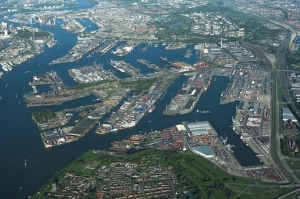


(Posted on 11/03/21)
The online publication of the Annual Report 2020 for the Port of Rotterdam Authority reveals that in a year when society at large was severely disrupted, the port of Rotterdam has confirmed its role as a reliable partner in the logistics chain by staying open 24/7. Goods volumes recovered in the second half year, limiting the decline in annual volume to 6.9% by comparison with the previous year. The financial results were better than in 2019, primarily due to one-off income items and cost savings. The net result was €351.7 million.
'The title of our annual report accurately reflects how we experienced 2020. It was a turbulent year. We were constantly looking for, and finding, solutions to a succession of new questions. Working with a large range of parties, we successfully kept the port fully operational. We are proud of that success,' said Allard Castelein CEO Port of Rotterdam Authority.
The port achieved throughput of 436.8 million tonnes in 2020, 6.9% less than in 2019. Despite the disruptive impact of the COVID-19 pandemic on the economy, production and logistics, the port of Rotterdam remained fully operational. The economic impact of the COVID-19 pandemic was the primary factor behind the decrease in volume. Throughput in Greater Rotterdam includes throughput in the terminals Hook of Holland, Dordrecht, Schiedam and Vlaardingen. In 2020, this throughput accounted for 4.1% of the total throughput volume for incoming and outgoing flows.
The throughput of dry bulk amounted to 63.8 million tonnes, 14.3% less than in 2019. Dry bulk accounts for 15% of throughput in the port of Rotterdam. Falling volumes were seen primarily in the throughput of iron ore and scrap (-24.5%) and coal (-22.8%). Incoming iron ore fell, mainly due to a major decline in German steel production. The steel factories that use the port of Rotterdam for the supply of ore are producing much less than usual. Demand for steel fell sharply from March onwards as a result of production stoppages in the automotive industry and construction. A low gas price meant that more gas and less coal was used for power production. In addition, favourable weather conditions meant that there was an increase in the available wind energy, reducing the need to switch to coal-fired power stations. The Onyx power station on the Maasvlakte was also shut down. There was a sharp increase in biomass (+108.3%) due to the continued rise in co-firing in power stations. Agricultural bulk also rose, mainly due to more imports and stockpiling.
The port of Rotterdam had a safe year for shipping. There were no very serious nautical accidents, with the number being almost unchanged from 2019.
With this year’s Rail Conference “Rail Freight Transport and Seaports”, a joint initiative... Read more
Asian Bulk Logistics (ABL Group) and ICG have jointly announced the successful completion of ABL&rsquo... Read more
Abu Dhabi based AD Ports Group, a leading global enabler of integrated trade, industry and logistics... Read more
The Executive Board of Hamburger Hafen und Logistik AG (HHLA) has appointed Patrick Krawutschke as Managing... Read more
Abu Dhabi based AD Ports Group, a global enabler of integrated trade, transport, industry, and logistics... Read more
This year marks a significant milestone in maritime innovation as Port Hedland, Australia, celebrates... Read more
Associated British Ports (ABP), the UK’s leading port operator, has announced the latest tranche... Read more
During the Investment, Labour, and Trade Promotion Programme in Japan (November 16–22, 2025),... Read more
AD Ports Group subsidiary Khalifa Economic Zones Abu Dhabi - KEZAD Group, the largest operator of integrated... Read more
Abu Dhabi based AD Ports Group, a global enabler of integrated trade, transport, industry, and logistics... Read more